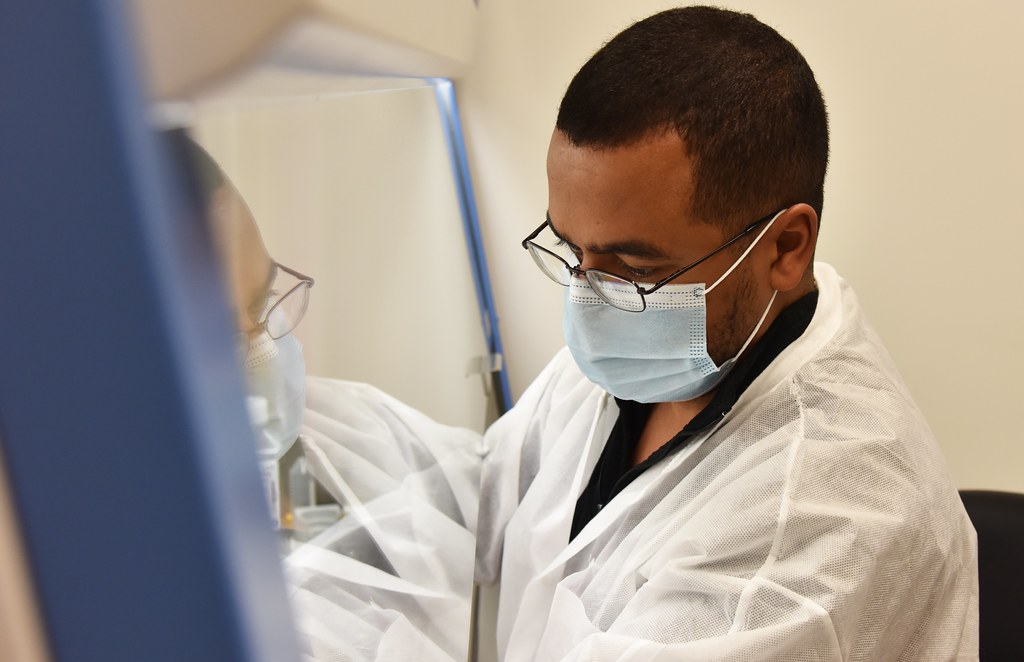Published on

By Lauren Hines | Bond LSC
Saliva is often something people take for granted.
It helps break down food, maintain teeth and keep the oral cavity feeling comfortable. But head and neck cancer patients lose those benefits when chemotherapy treatments damage their salivary glands.
Olga Baker set out to research tissue regeneration for these cancer patients by collaborating with the Michael Petris and Gary Weisman labs after setting up shop four months ago as a new principal investigator at Bond Life Sciences Center.
Together, the Petris and Baker labs are looking at the role of copper in salivary gland damage.
“Nobody has asked what happens to copper metabolism during and after head and neck radiation,” Baker said. “Is copper related to the fibrosis that is developing in those patients, so they don’t make saliva? We don’t know. So, we are answering different questions…. We don’t have any data yet, but what we have is immunofluorescence studies showing that those copper transporters are present in salivary glands from mice and humans.”
If the two labs can learn how copper connects to salivary gland tissue regeneration, Baker can get a step closer to helping patients.
The Baker and Petris labs just published a paper with help from the Proteomics Center and the MU Molecular Interactions Core in the journal of Dental Research. Post doctorate Harim Tavares from the Baker lab is the leading author.
The study used synthetic networks of crosslinked polymer chains that can take in large amounts of water called, smart hydrogels. The smart hydrogels were used in the same mouse model as the cell sheets and promoted tissue regeneration on mouse salivary glands. The paper explored how different materials like smart hydrogels can improve tissue regeneration.
Baker’s other focus takes on cancer and tissue regeneration from a different angle in her collaboration with the Weisman lab.
“Dr. Weisman’s group has studied the mechanisms of salivary gland dysfunction for over 30 years, so between these two groups the tools are in place to provide a translational approach to understand and treat salivary gland disorders,” said Jean Camden, a senior research associate in the Weisman lab.
The two labs just submitted a paper on mouse submandibular glands and cell sheets, which are plastic-like sheets where cells grow and detach once it reaches a certain temperature. Kihoon Nam from the Baker lab is the corresponding author. The study transplanted submandibular gland cell sheets into a wounded mouse to see if cells could be transferred.
“We believe that is a good proof of concept for future use in radiation studies,” Baker said.
The Baker lab uses cell sheets with the Weisman lab to study the role of the P2Y2 receptor in salivary gland regeneration. P2Y2 is a plasma membrane receptor that binds the molecules outside of cells and serves as signals to trigger an action.
The Weisman lab previously showed that P2Y2 receptor activation encourages salivary gland cells to migrate together and form a unit capable of secreting saliva.
“At this time, we don’t know what the role of P2Y2R is in the cell sheets,” Camden said. “That is an aim we proposed in a recent TRIUMPH proposal.”
The TRIUMPH initiative — The Translational Research Informing Useful and Meaningful Precision Health initiative — is a pilot grant funding opportunity through the Missouri School of Medicine.
As if two collaborations weren’t enough, Baker is also working on saliva substitutes. The lab just submitted a grant to fund the project.
“If we get the money, we will be able to make a far better saliva substitute as compared to the Biotine, or Aquoral, or Oasis,” Baker said. “Those are the three leading brands. So, hopefully, we can make something better here at MU and commercialize the product.”